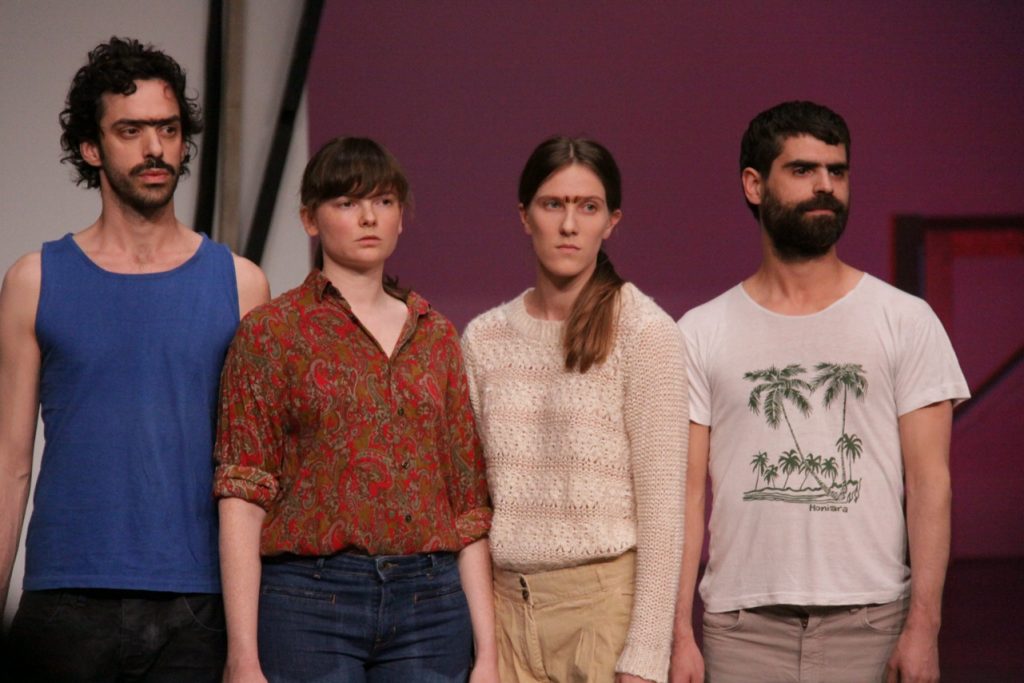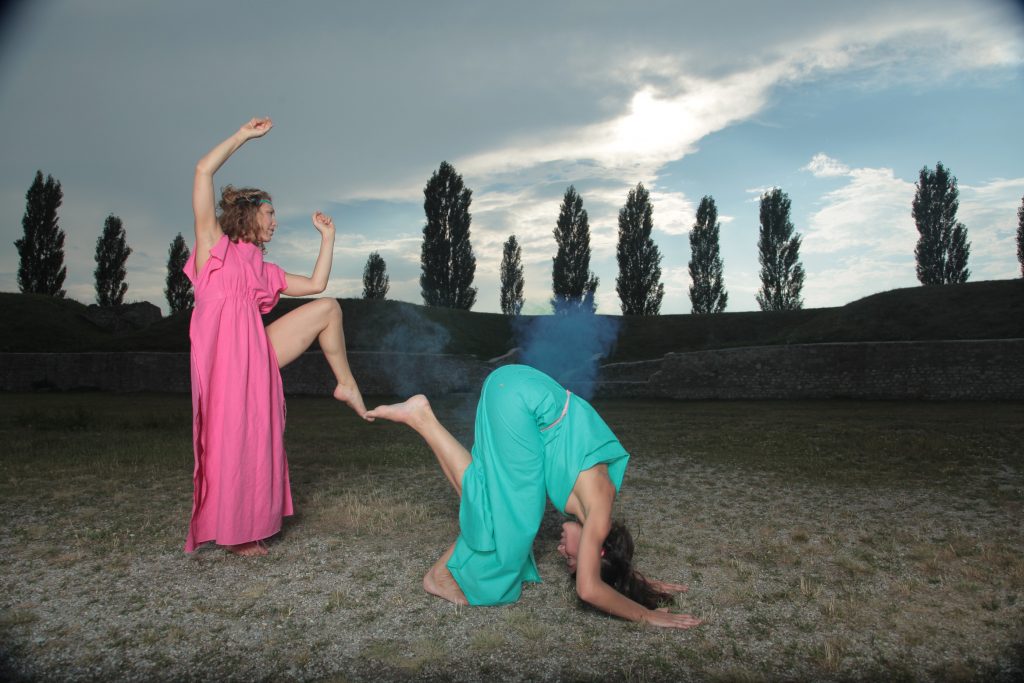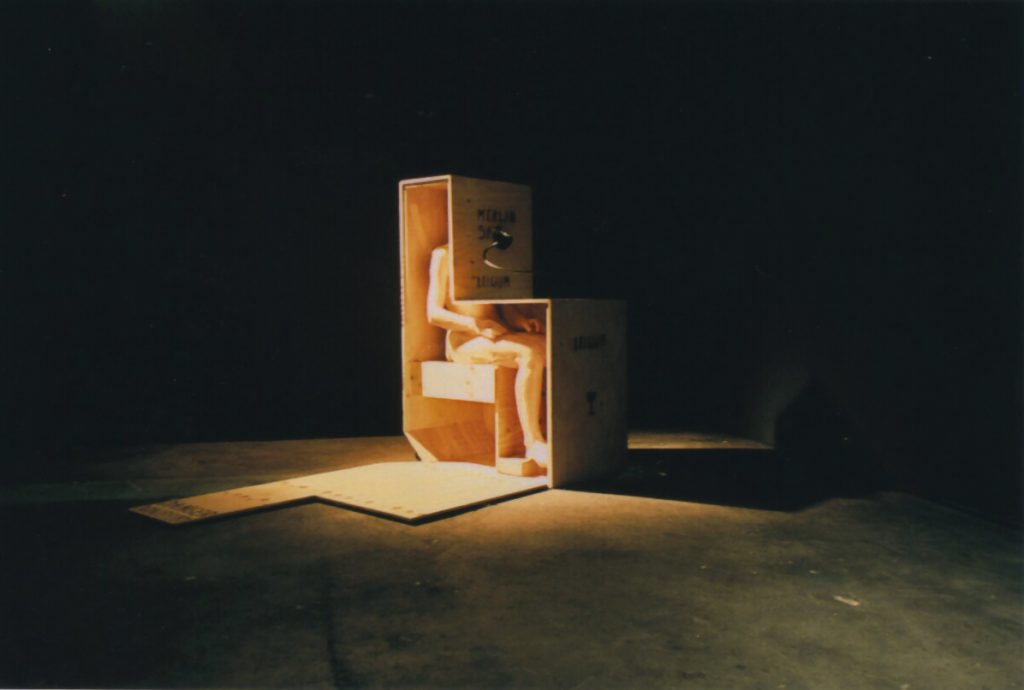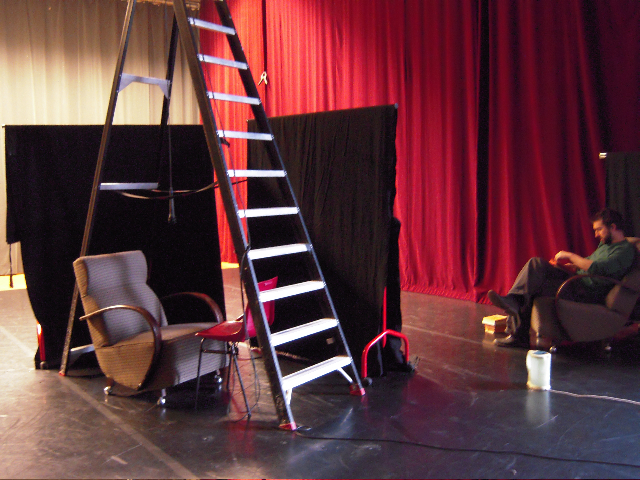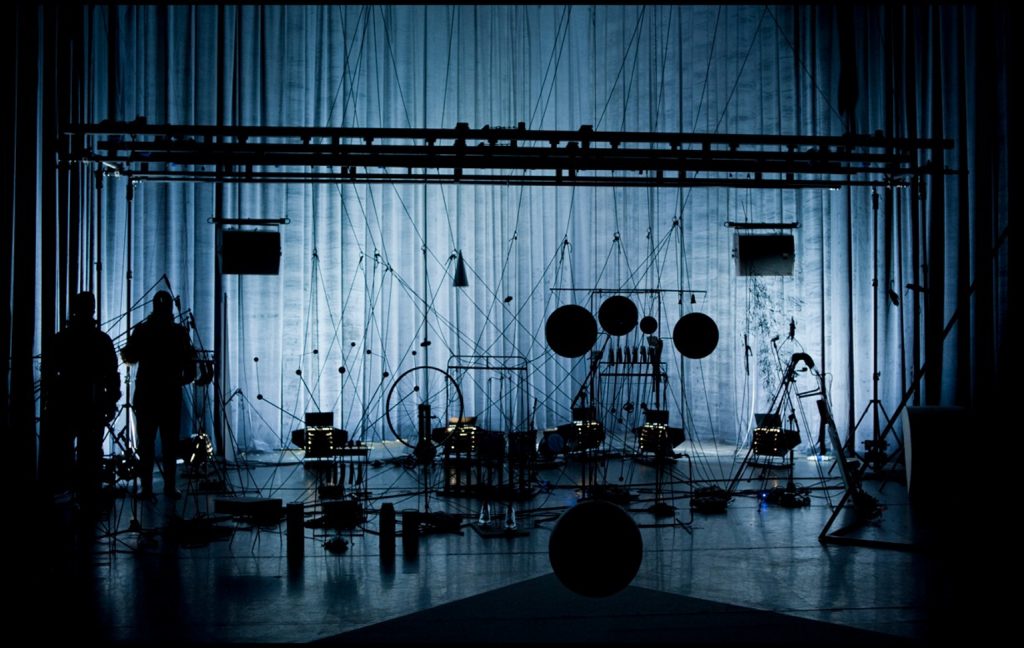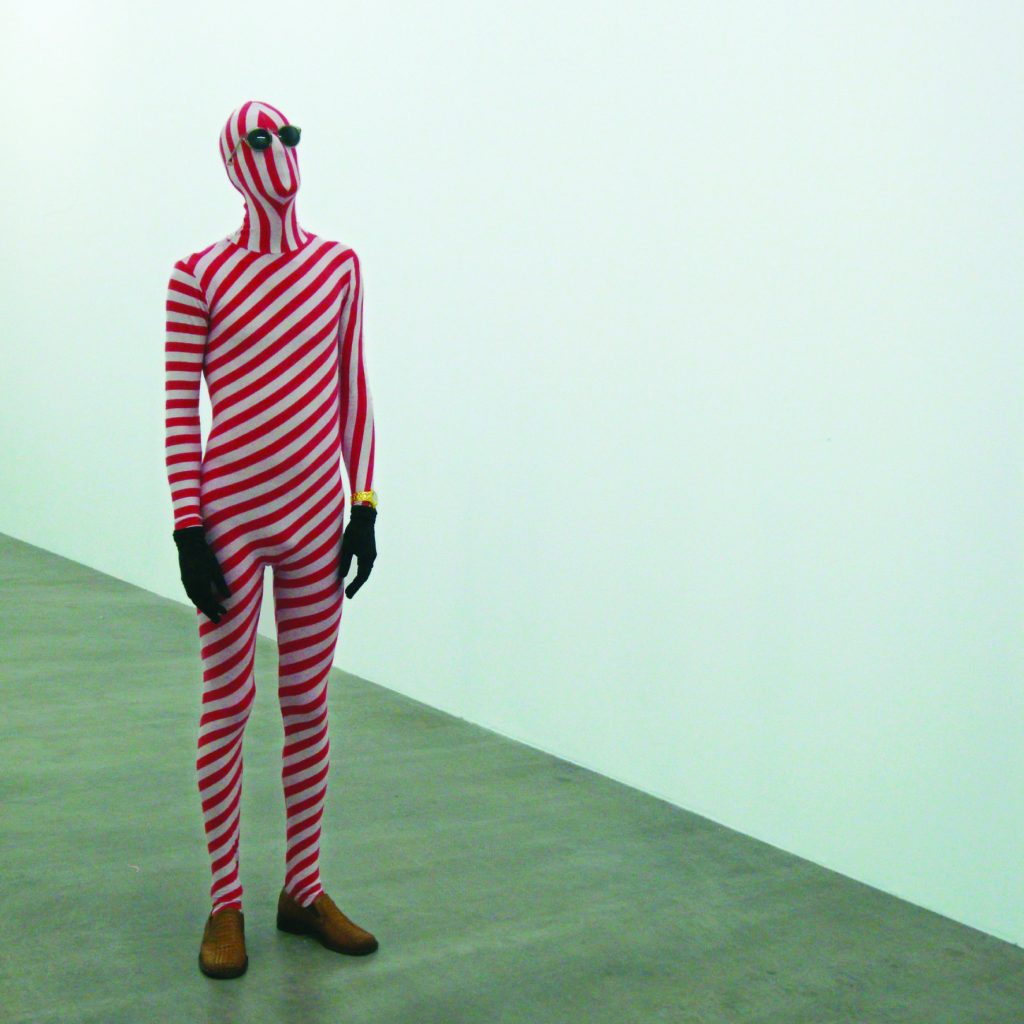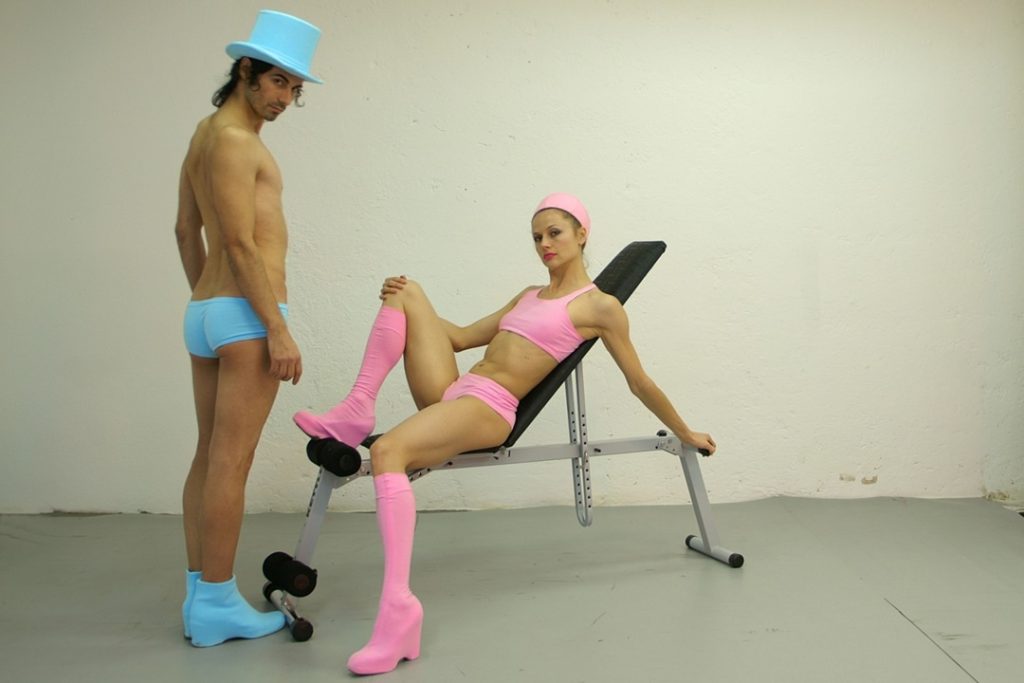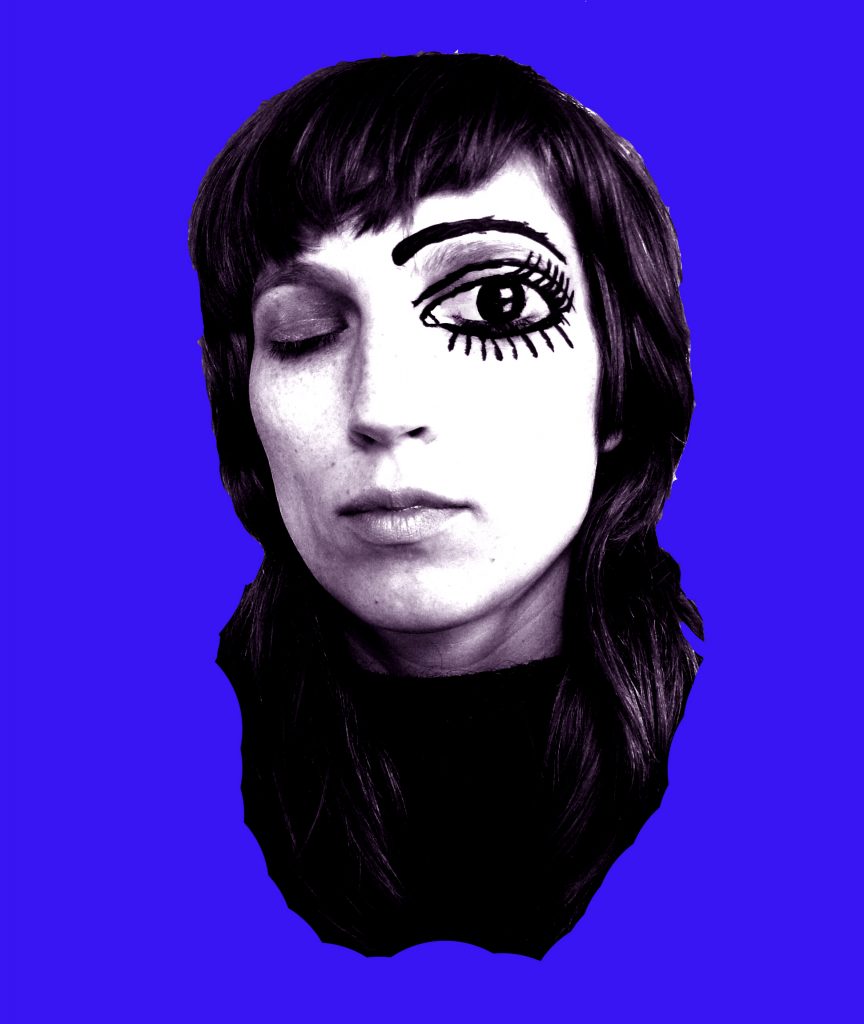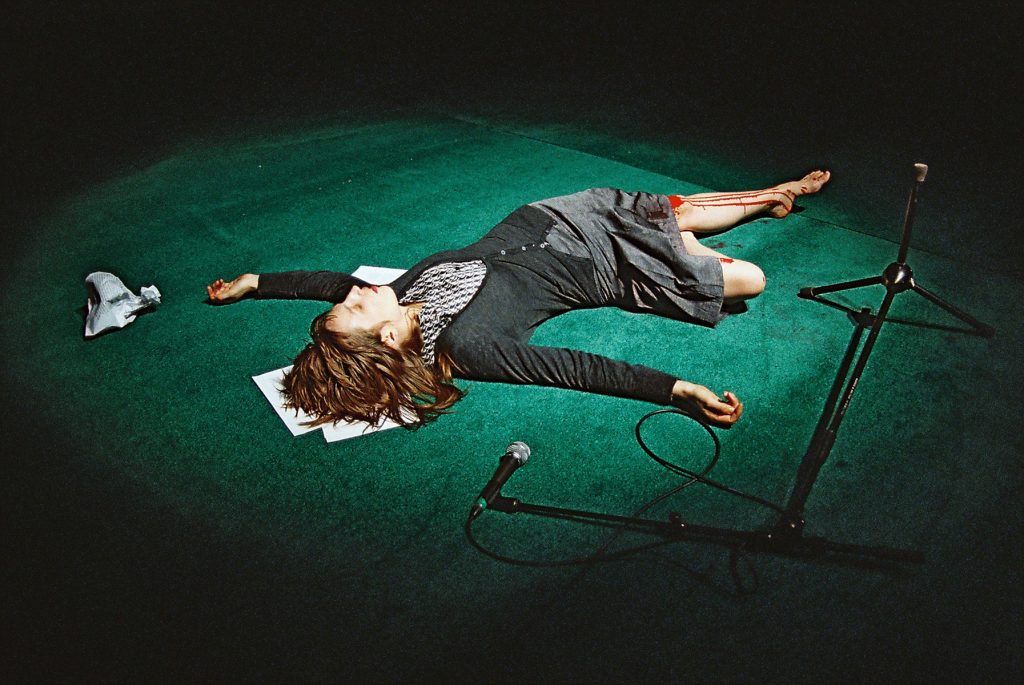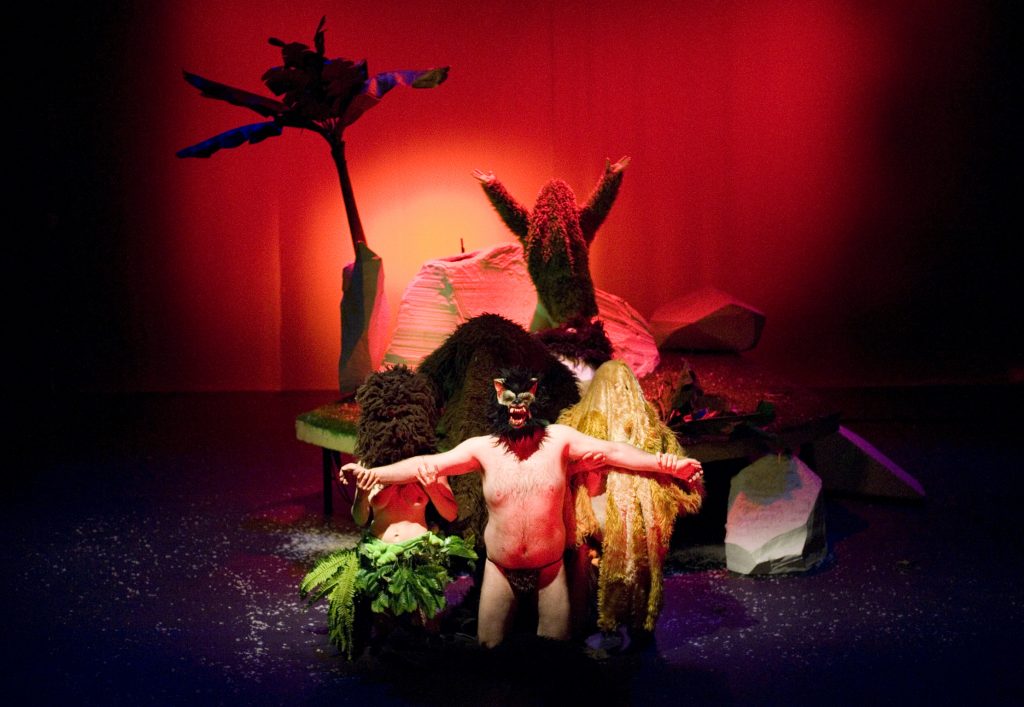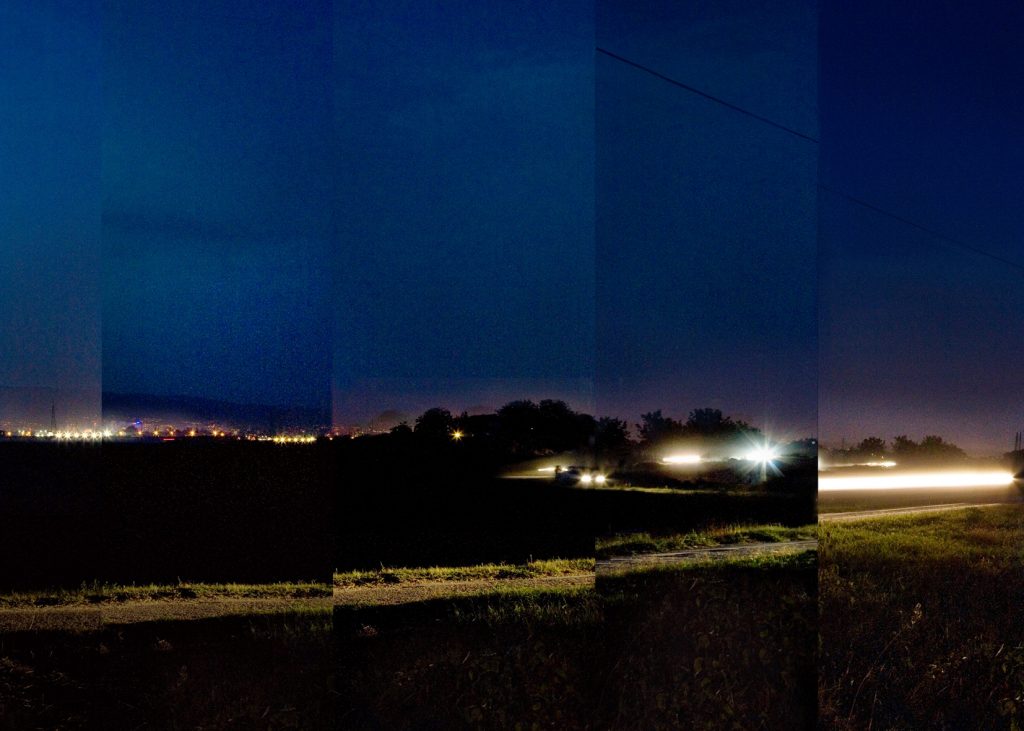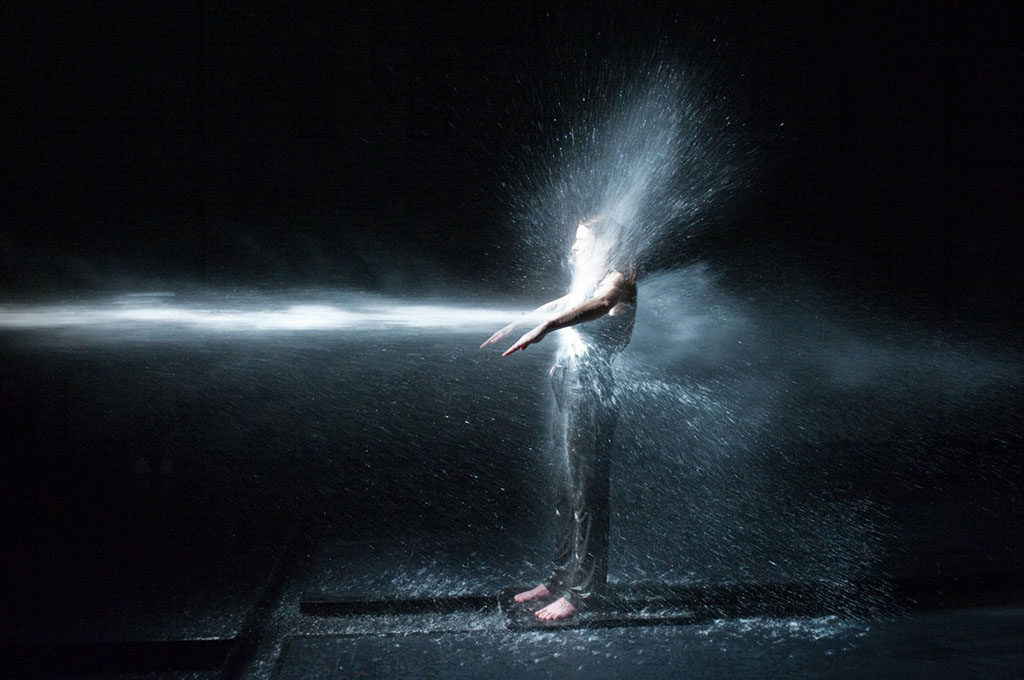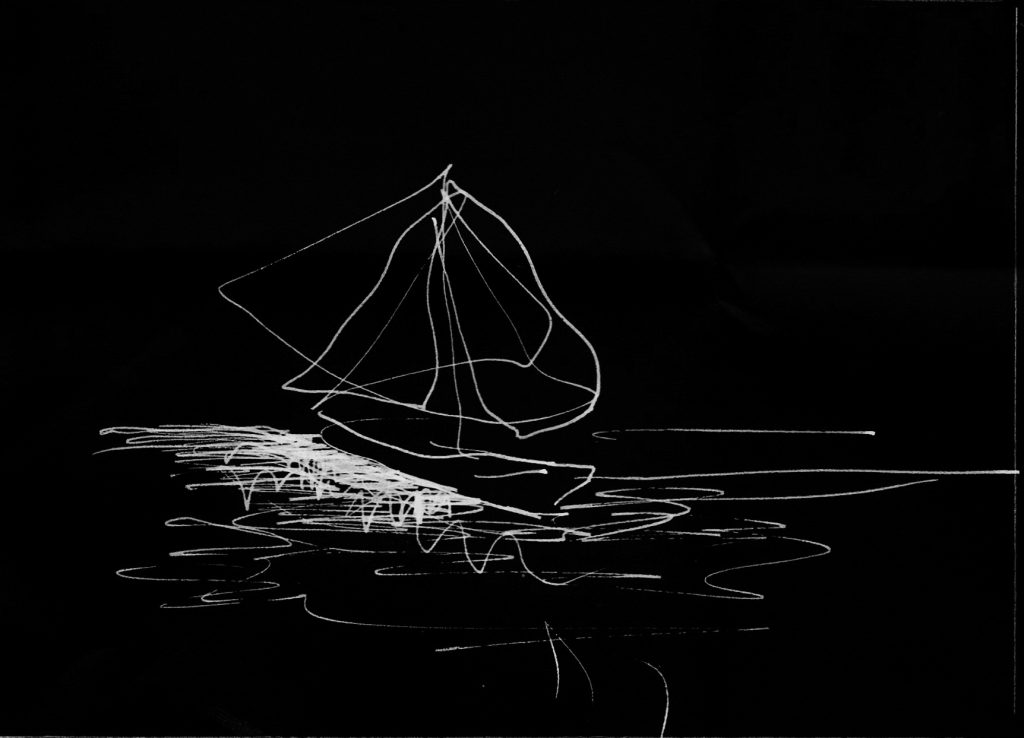Faire un Four is an expression from the 17th century theatre world which means “to suffer a defeat”. Literally it is “to make an oven” but it almost sounds like “to make a four” hence “a quartet”.
Agenda
Filter by artist
Roch Baumert, Alix Eynaudi & Diederik Peeters will dress up as Romans, lay down on a bench, and eat and drink as much as they can, while addressing the topics of the day.
Roch Baumert, Alix Eynaudi & Diederik Peeters will dress up as Romans, lay down on a bench, and eat and drink as much as they can, while addressing the topics of the day.
A polyester sculpture is enclosed in a timber chest. During the performance the artist breathes through a diving gear.
The title refers to the small signs one can read in a zoo.
The body of a man feed by material and/or spiritual ingredients, appears at a given moment thanks to external and internal sensory receivers, through artificial breathing, through the internal functioning of the organs. There are links and interconnections; the exchange of ‘food’ makes us get in and out of the body. The dimension of social responsibility can be seen and it questions the careless exhibiting of a creature with a soul.
Moving You is not your everyday show. There are no characters. There is no story.
“Yes, and I personally met the devil at least three times face to face.”
This musical performance focuses on a machine that apparently produces confusing near-death experiences and on a Rumanian singer that believes herself to be somewhere in between life and death. She’s being watched by three dark figures from an intermediate world. They serve as her shadow, her guide, the personification of her demons, and as the engineers of the ecstatic experience machine. What in reality only lasts some hundreds of seconds, she perceives as eternity. Because of the repetitive character of her experience, every possible ending seems to be a return to the beginning. She runs through several phases from devotion, doubt, total obsession and ecstasy.
‘Zanahoria’ is a lecture about the proverbial carrot one holds in front of a donkey in order to make it move. For the follow-up of their cult-hit ‘Chuck Norris doesn’t sleep, he waits…’ (2007), Bryssinck & Peeters (at that time still with Danai Anesiadou) went searching for the ‘ultimate image’. This image would on one hand have to represent the trio and on the other be the perfect translation of their wildest imagination. They asked other artists to guide them on this quest, hoping that in this way unexpected and unpredictable elements would steal into their work, in order to surprise themselves. ‘Zanahoria’ light-headedly tells the story of this quest; a crazy oscillation between hopeful expectation and disappointment, between hilarity and despair, between truth and fiction, and between the dullness of reality and untainted imagination.
“Yes, and I personally met the devil at least three times face to face.”
This musical performance focuses on a machine that apparently produces confusing near-death experiences and on a Rumanian singer that believes herself to be somewhere in between life and death. She’s being watched by three dark figures from an intermediate world. They serve as her shadow, her guide, the personification of her demons, and as the engineers of the ecstatic experience machine. What in reality only lasts some hundreds of seconds, she perceives as eternity. Because of the repetitive character of her experience, every possible ending seems to be a return to the beginning. She runs through several phases from devotion, doubt, total obsession and ecstasy.
A polyester sculpture is enclosed in a timber chest. During the performance the artist breathes through a diving gear.
The title refers to the small signs one can read in a zoo.
The body of a man feed by material and/or spiritual ingredients, appears at a given moment thanks to external and internal sensory receivers, through artificial breathing, through the internal functioning of the organs. There are links and interconnections; the exchange of ‘food’ makes us get in and out of the body. The dimension of social responsibility can be seen and it questions the careless exhibiting of a creature with a soul.
“Yes, and I personally met the devil at least three times face to face.”
This musical performance focuses on a machine that apparently produces confusing near-death experiences and on a Rumanian singer that believes herself to be somewhere in between life and death. She’s being watched by three dark figures from an intermediate world. They serve as her shadow, her guide, the personification of her demons, and as the engineers of the ecstatic experience machine. What in reality only lasts some hundreds of seconds, she perceives as eternity. Because of the repetitive character of her experience, every possible ending seems to be a return to the beginning. She runs through several phases from devotion, doubt, total obsession and ecstasy.
‘Zanahoria’ is a lecture about the proverbial carrot one holds in front of a donkey in order to make it move. For the follow-up of their cult-hit ‘Chuck Norris doesn’t sleep, he waits…’ (2007), Bryssinck & Peeters (at that time still with Danai Anesiadou) went searching for the ‘ultimate image’. This image would on one hand have to represent the trio and on the other be the perfect translation of their wildest imagination. They asked other artists to guide them on this quest, hoping that in this way unexpected and unpredictable elements would steal into their work, in order to surprise themselves. ‘Zanahoria’ light-headedly tells the story of this quest; a crazy oscillation between hopeful expectation and disappointment, between hilarity and despair, between truth and fiction, and between the dullness of reality and untainted imagination.
Manteau Long en laine marine porté sur un pull à encolure détendue avec un pantalon peau de pêche et des chaussures pointues en nubuck rouge. “Manteau Long…” analyses a creation process and reveals what is normally not explicitly shown: the actions, gestures and attitudes that necessitate a dance act. Fundamentally dependent on the direct relationship with the witnessing public, this performance – serious and playful – sums up what a dancer does, can do, or isn’t able to do.
Manteau Long en laine marine porté sur un pull à encolure détendue avec un pantalon peau de pêche et des chaussures pointues en nubuck rouge. “Manteau Long…” analyses a creation process and reveals what is normally not explicitly shown: the actions, gestures and attitudes that necessitate a dance act. Fundamentally dependent on the direct relationship with the witnessing public, this performance – serious and playful – sums up what a dancer does, can do, or isn’t able to do.
Manteau Long en laine marine porté sur un pull à encolure détendue avec un pantalon peau de pêche et des chaussures pointues en nubuck rouge. “Manteau Long…” analyses a creation process and reveals what is normally not explicitly shown: the actions, gestures and attitudes that necessitate a dance act. Fundamentally dependent on the direct relationship with the witnessing public, this performance – serious and playful – sums up what a dancer does, can do, or isn’t able to do.
DARK MATTER is a performance from Kate McIntosh hosted by a woman in a spotlight, dressed in a sparkling dress and a long grey beard. With the help of two assistants, some small strange dances and a few materials you might or might not have at home, DARK MATTER approaches the big scientific-philosophical questions in a full-on show-biz late-night theatre style, illustrating these knotty conundrums – time and gravity, being and not being, thought and the body – through what look suspiciously like a series of improvised home-science experiments.
Some stories are treason, some are dreamy, some are brutal, some are too funny to believe, some are too painful to tell straight, some are magical and others are poorly made, some might be the honest truth, and some are beautiful but hard to remember. A narrative is a slippery thing.
Kate McIntosh has collaborated with five writers to make the performance text for LOOSE PROMISE. She gave each of them the same set of narrative ingredients to start from, but asked each to write their own version of the story. The result is a collection of beautiful, difficult and compelling narratives. The stories are bound by their shared origin, but they head out in very different and surprising directions. The narratives of LOOSE PROMISE create worlds that echo each other, and yet can hardly co-exist. The performance itself, sparked by a fascination with the interdependence of stories, explores our compulsion to keep forming and digesting them….
Manteau Long en laine marine porté sur un pull à encolure détendue avec un pantalon peau de pêche et des chaussures pointues en nubuck rouge. “Manteau Long…” analyses a creation process and reveals what is normally not explicitly shown: the actions, gestures and attitudes that necessitate a dance act. Fundamentally dependent on the direct relationship with the witnessing public, this performance – serious and playful – sums up what a dancer does, can do, or isn’t able to do.
Manteau Long en laine marine porté sur un pull à encolure détendue avec un pantalon peau de pêche et des chaussures pointues en nubuck rouge. “Manteau Long…” analyses a creation process and reveals what is normally not explicitly shown: the actions, gestures and attitudes that necessitate a dance act. Fundamentally dependent on the direct relationship with the witnessing public, this performance – serious and playful – sums up what a dancer does, can do, or isn’t able to do.
DARK MATTER is a performance from Kate McIntosh hosted by a woman in a spotlight, dressed in a sparkling dress and a long grey beard. With the help of two assistants, some small strange dances and a few materials you might or might not have at home, DARK MATTER approaches the big scientific-philosophical questions in a full-on show-biz late-night theatre style, illustrating these knotty conundrums – time and gravity, being and not being, thought and the body – through what look suspiciously like a series of improvised home-science experiments.
Manteau Long en laine marine porté sur un pull à encolure détendue avec un pantalon peau de pêche et des chaussures pointues en nubuck rouge. “Manteau Long…” analyses a creation process and reveals what is normally not explicitly shown: the actions, gestures and attitudes that necessitate a dance act. Fundamentally dependent on the direct relationship with the witnessing public, this performance – serious and playful – sums up what a dancer does, can do, or isn’t able to do.
Manteau Long en laine marine porté sur un pull à encolure détendue avec un pantalon peau de pêche et des chaussures pointues en nubuck rouge. “Manteau Long…” analyses a creation process and reveals what is normally not explicitly shown: the actions, gestures and attitudes that necessitate a dance act. Fundamentally dependent on the direct relationship with the witnessing public, this performance – serious and playful – sums up what a dancer does, can do, or isn’t able to do.
DAVID, a travel through immobility
Manteau Long en laine marine porté sur un pull à encolure détendue avec un pantalon peau de pêche et des chaussures pointues en nubuck rouge. “Manteau Long…” analyses a creation process and reveals what is normally not explicitly shown: the actions, gestures and attitudes that necessitate a dance act. Fundamentally dependent on the direct relationship with the witnessing public, this performance – serious and playful – sums up what a dancer does, can do, or isn’t able to do.
DARK MATTER is a performance from Kate McIntosh hosted by a woman in a spotlight, dressed in a sparkling dress and a long grey beard. With the help of two assistants, some small strange dances and a few materials you might or might not have at home, DARK MATTER approaches the big scientific-philosophical questions in a full-on show-biz late-night theatre style, illustrating these knotty conundrums – time and gravity, being and not being, thought and the body – through what look suspiciously like a series of improvised home-science experiments.
DAVID, a travel through immobility
Why do communities feel the need to stage their fear? Are they invoking occult powers just to be able to expel them more easily? Depauw is fascinated by the fragile balance between madness and possession, simulation and acting. In her quest for a primordial Eden, she draws from mythology, carnival and folklore: inexhaustible sources of inspiration for the masks, costumes and iconography running through her latest work. She conceives her Eden Central as a deep jungle, a world of science fiction where people attempt to get away from savagery to attain civilisation. Ultimately, to become human beings…
Manteau Long en laine marine porté sur un pull à encolure détendue avec un pantalon peau de pêche et des chaussures pointues en nubuck rouge. “Manteau Long…” analyses a creation process and reveals what is normally not explicitly shown: the actions, gestures and attitudes that necessitate a dance act. Fundamentally dependent on the direct relationship with the witnessing public, this performance – serious and playful – sums up what a dancer does, can do, or isn’t able to do.
Everything ok?
Yes, all is good.
So simple and extensive is this performance of Leentje Vandenbussche.
O is like an open buffet of All, in his greatest elusive form, and our all in our everyday environment. Do you go straight for the full load or do you carefully compose each plate? Everything is in your own hands. Without prying eyes. Without accountability. Everything is possible. Everything is good.
Manteau Long en laine marine porté sur un pull à encolure détendue avec un pantalon peau de pêche et des chaussures pointues en nubuck rouge. “Manteau Long…” analyses a creation process and reveals what is normally not explicitly shown: the actions, gestures and attitudes that necessitate a dance act. Fundamentally dependent on the direct relationship with the witnessing public, this performance – serious and playful – sums up what a dancer does, can do, or isn’t able to do.
Faire un Four is an expression from the 17th century theatre world which means “to suffer a defeat”. Literally it is “to make an oven” but it almost sounds like “to make a four” hence “a quartet”.
DARK MATTER is a performance from Kate McIntosh hosted by a woman in a spotlight, dressed in a sparkling dress and a long grey beard. With the help of two assistants, some small strange dances and a few materials you might or might not have at home, DARK MATTER approaches the big scientific-philosophical questions in a full-on show-biz late-night theatre style, illustrating these knotty conundrums – time and gravity, being and not being, thought and the body – through what look suspiciously like a series of improvised home-science experiments.
Waiting for the tram, waiting for the espresso machine, waiting for a lettre, waiting for a lover. We are daily confronted with waiting in a thousand and one shapes. It is a part of life, or maybe, it is life in itself.
Everything ok?
Yes, all is good.
So simple and extensive is this performance of Leentje Vandenbussche.
O is like an open buffet of All, in his greatest elusive form, and our all in our everyday environment. Do you go straight for the full load or do you carefully compose each plate? Everything is in your own hands. Without prying eyes. Without accountability. Everything is possible. Everything is good.
Why do communities feel the need to stage their fear? Are they invoking occult powers just to be able to expel them more easily? Depauw is fascinated by the fragile balance between madness and possession, simulation and acting. In her quest for a primordial Eden, she draws from mythology, carnival and folklore: inexhaustible sources of inspiration for the masks, costumes and iconography running through her latest work. She conceives her Eden Central as a deep jungle, a world of science fiction where people attempt to get away from savagery to attain civilisation. Ultimately, to become human beings…
Faire un Four is an expression from the 17th century theatre world which means “to suffer a defeat”. Literally it is “to make an oven” but it almost sounds like “to make a four” hence “a quartet”.
Why do communities feel the need to stage their fear? Are they invoking occult powers just to be able to expel them more easily? Depauw is fascinated by the fragile balance between madness and possession, simulation and acting. In her quest for a primordial Eden, she draws from mythology, carnival and folklore: inexhaustible sources of inspiration for the masks, costumes and iconography running through her latest work. She conceives her Eden Central as a deep jungle, a world of science fiction where people attempt to get away from savagery to attain civilisation. Ultimately, to become human beings…
Why do communities feel the need to stage their fear? Are they invoking occult powers just to be able to expel them more easily? Depauw is fascinated by the fragile balance between madness and possession, simulation and acting. In her quest for a primordial Eden, she draws from mythology, carnival and folklore: inexhaustible sources of inspiration for the masks, costumes and iconography running through her latest work. She conceives her Eden Central as a deep jungle, a world of science fiction where people attempt to get away from savagery to attain civilisation. Ultimately, to become human beings…
Why do communities feel the need to stage their fear? Are they invoking occult powers just to be able to expel them more easily? Depauw is fascinated by the fragile balance between madness and possession, simulation and acting. In her quest for a primordial Eden, she draws from mythology, carnival and folklore: inexhaustible sources of inspiration for the masks, costumes and iconography running through her latest work. She conceives her Eden Central as a deep jungle, a world of science fiction where people attempt to get away from savagery to attain civilisation. Ultimately, to become human beings…
Le silence des danses, comprises three performances in three different places in the Kaaistudios.
In this work Spie is taking a new direction. She departs from the purely visual and enters into confrontation with other media: digital images, soundscapes, text, dance, etc. This choice has led to a different way of organising her work: it implies collaboration with artists who work in a variety of areas. What is more, Spie has until now been the main and often only performer in her work.
In the first two parts of Le silence des danses, she takes on the role of director-sculptor of other performers. In the third she herself takes part. However, this new phase in her work above all signifies the next step in her quest for abstraction and purity and a transition from still, frozen, breathing images to moving images.
Le silence des danses means: embracing abstraction, letting movement take its own course, not letting go of one’s intuition.
Why do communities feel the need to stage their fear? Are they invoking occult powers just to be able to expel them more easily? Depauw is fascinated by the fragile balance between madness and possession, simulation and acting. In her quest for a primordial Eden, she draws from mythology, carnival and folklore: inexhaustible sources of inspiration for the masks, costumes and iconography running through her latest work. She conceives her Eden Central as a deep jungle, a world of science fiction where people attempt to get away from savagery to attain civilisation. Ultimately, to become human beings…
Why do communities feel the need to stage their fear? Are they invoking occult powers just to be able to expel them more easily? Depauw is fascinated by the fragile balance between madness and possession, simulation and acting. In her quest for a primordial Eden, she draws from mythology, carnival and folklore: inexhaustible sources of inspiration for the masks, costumes and iconography running through her latest work. She conceives her Eden Central as a deep jungle, a world of science fiction where people attempt to get away from savagery to attain civilisation. Ultimately, to become human beings…
For their new stage production Kayak-performers Bernard Van Eeghem, Catherine Graindorge and Katja Dreyer team up as a threesome for the first time. Kayak is their first collaborative research on the notion of falling and failing. The reckless kayak sea-travel by Andrew McAuley, the artistic conception of falling by Dutch artist Bas Jan Ader and Philippe Petit’s rope dancing, guide them through their theatrical quest. The trio balances as equilibrists on the thin line between earnest and lightheartedness, philosophy and proverbial wisdom.
For their new stage production Kayak-performers Bernard Van Eeghem, Catherine Graindorge and Katja Dreyer team up as a threesome for the first time. Kayak is their first collaborative research on the notion of falling and failing. The reckless kayak sea-travel by Andrew McAuley, the artistic conception of falling by Dutch artist Bas Jan Ader and Philippe Petit’s rope dancing, guide them through their theatrical quest. The trio balances as equilibrists on the thin line between earnest and lightheartedness, philosophy and proverbial wisdom.
